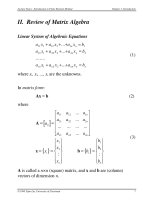chapter 10 solution lecture notes
Bạn đang xem bản rút gọn của tài liệu. Xem và tải ngay bản đầy đủ của tài liệu tại đây (1.94 MB, 37 trang )
Chapter 10
Properties of Solutions
17.1 Solution Composition
17.2 The Thermodynamics of Solution Formation (skip)
17.3 Factors Affecting Solubility
17.4 The Vapor Pressures of Solutions
17.5 Boiling-Point Elevation and Freezing-Point
Depression
17.6 Osmotic Pressure
17.7 Colligative Properties of Electrolyte Solutions
17.8 Colloids
os
it
ion
tio
n
De
p
Su
b li
ma
ap
Ev
SOLID
n
tio
sa
en
on
nd
ati
Co
or
GAS
Melting
Freezing
LIQUID
Colligative Properties of Solutions
•
•
For Colligative properties, the difference between a pure solvent and dilute solution
depends only on the number of solute particles present and not on their chemical
identity.
Examples
–
–
–
–
Vapor Pressure Depression
Boiling Point Elevation
Melting Point Depression
Osmotic Pressure
Lowering of Vapor Pressure
–
Vapor Pressure of a solvent above a dilute
solution is always less than the vapor pressure
above the pure solvent.
Elevation of Boiling Point
–
The boiling point of a solution of a non-volatile
solute in a volatile solvent always exceeds the
boiling point of a pure solvent
Boiling
•
liquid in equilibrium with its vapor at the external pressure.
Boiling Point
•
Vapor press = external pressure
Normal boiling point
•
Vap press. = 1 atm
Elevation of Boiling
Point & Vapor
Pressure Depression
∆T = K m
b solute
ΔT is the boiling point elevation
Kb is molal boiling - point elevation constant
m
is the molality of the solute in solution
solute
Phase diagrams for pure water (red
lines)
and for an aqueous solution
containing a nonvolatile
solution (blue lines).
Solution Composition
The solute and solvent can be any
combination of solid (s), liquid (l), and
gaseous (g) phases.
Dissolution: Two (or more) substances mix at the level of
individual atoms, molecules, or ions.
Solution: A homogeneous mixture (mixed at level of atoms
molecules or ions
Solvent: The major component
Solute: The minor component
Solution Composition
Mass Fraction, Mole Fraction, Molality and
Molarity
Mass percentage (weight percentage):
mass percentage of the component =
mass of component
total mass of mixture
X 100%
Mole fraction: The amount of a given component (in moles)
divided by the total amount (in moles)
X1 = n1/(n1 + n2) for a two component system
X2 = n2/(n1 + n2) = 1 – X1 or X1+X2=1
Molality
msolute =
moles solute per kilogram solvent
= moles per kg or (mol kg-1)
Molarity (biochemists pay attention)
csolute =
moles solute per volume solution
= moles per liter of solution (mol L-1)
Factors Affecting Solubility
1.
Molecular Interactions
– Review chapter 4
– Polar molecules, water soluble, hydrophilic
(water loving)
•
E.g., Vitamins B and C; water-soluble
– Non-polar molecules, soluble in non-polar
molecules, hydrophobic (water fearing)
•
E.g., Vitamins A, D, K and E; fat-soluble
Factors Affecting Solubility of Gases
1.
2.
Structure Effects
Pressure Effects
Henry’s Law (for dilute solutions)
The mole fraction of volatile solute is
proportional to the vapor pressure of the
solute.
P = kH X
kH = Henry’s Law constant, X = mole fraction.
Increasing the partial pressure of a gas over a liquid increases the amount of gas disolved
in the liquid.
kH depends on temperature.
When the partial pressure of nitrogen over a sample of water at
19.4°C is 9.20 atm, the concentration of nitrogen in the water is
5.76 x 10-3 mol L-1. Compute Henry’s law constant for nitrogen in
water at this temperature.
Given
PN = 9.20 atm
2
c N = [N 2 ] = 5.76x10 −3 mol/L
2
Henry's Law
PN = k N X N
2
XN =
2
2
2
nN
nN + nH
2
≈
2
2O
nN
nH
2
2O
When the partial pressure of nitrogen over a sample of water at
19.4°C is 9.20 atm, then the concentration of nitrogen in the
water is 5.76 x 10-3 mol L-1. Compute Henry’s law constant for
nitrogen in water at this temperature.
PN = k N X N
Given
PN = 9.20 atm
2
2
c N = [N 2 ] = 5.76x10− 3 mol/l
2
Henry' s Law
PN = k N X N
2
XN =
2
2
nN
2
nN + nH
2
≈
2
O
2
nN
nH
2
2
rearrange
PN
Given
2
kN =
=
XN
Find
2
2
2
O
2
Next assume 1 Liter
When the partial pressure of nitrogen over a sample
of water at 19.4°C is 9.20 atm, then the
concentration of nitrogen in the water is 5.76 x 10-3
mol L-1. Compute Henry’s law constant for nitrogen
PN
in water at this temperature.
Given
2
kN
XN
kN
2
2
≈
nN
nH
2
2O
2
=
XN
=
Find
2
5.76x10 −3 mol/l
=
1000g/l
18g/mol
= 1.0378 x 10 − 4
PN
Given
9.20 atm
2
=
=
=
XN
Find
1.0378x10 − 4
2
= 8.86 x 10 4 atm
Factors Affecting Solubility
1.
2.
3.
Structure Effects
Pressure Effects
Temperature Effects for Aqueous Solutions
The solubility of some
solids as a function of
temperature.
The aqueous solubilities of most solids
increase with increasing temperature,
some decrease with temp.
Endothermic – heat is absorbed by the
system (think evaporation of water, or
melting of ice)
Exothermic – heat is evolved by the system
(think fire, or freezing of water).
Factors Affecting Solubility
1.
2.
3.
Structure Effects
Pressure Effects
Temperature Effects for Aqueous Solutions
The solubility of some gases in
water as a function of
temperature at a constant
pressure of 1 atm.
The greatest gas solubility for a gas in
solution is predicted under what
conditions?
1)
2)
3)
4)
5)
low T, low P
low T, high P
high T, low P
high T, high P
solubility of gases does not depend
upon temperature
The greatest gas solubility for a gas in
solution is predicted under what
conditions?
1)
2)
3)
4)
5)
low T, low P
low T, high P
high T, low P
high T, high P
solubility of gases does not depend
upon temperature
According to Henry's Law, the solubility
of a gas in a liquid
1)
2)
3)
4)
depends on the polarity of the liquid
depends on the liquid's density
remains the same at all temperatures
increases as the gas pressure above the
solution increases
5)
decreases as the gas pressure above the
solution increases
According to Henry's Law, the solubility of
a gas in a liquid
1)
2)
3)
4)
depends on the polarity of the liquid
depends on the liquid's density
remains the same at all temperatures
increases as the gas pressure above
the solution increases
5)
decreases as the gas pressure above the
solution increases
The Person Behind the Science
Francois-Marie Raoult (1830-1901)
Highlights
–
–
1886 Raoult's law , the partial pressure of a solvent vapor in equilibrium
with a solution is proportional to the ratio of the number of solvent
molecules to non-volatile solute molecules.
allows molecular weights to be determined, and provides the explanation for
freezing point depression and boiling point elevation.
Moments in a Life
–
Raoult was a prominent member of the group which created physical
chemistry, including Arrhenius, Nernst, van t'Hoff, Planck.
For ideal
solutions
Psoln = XsolventP°solvent
Raoult’s Law, non-volatile solute
•
•
Consider a non-volatile solute (component 2) dissolved in a volatile solvent (component
1).
X1 = the mole fraction of solvent
Raoult’s Law
P1=X1 P°1
P°1 = the vapor
pressure of pure
component 1
Raoult’s Law, volatile solute
• Volatile solute (component 1)
• Volatile solvent (component 2)
P1 = X1 P°1
P2 = X2 P°2
Ptot = P1+ P2
Vapor pressure for a solution of two volatile liquids.
Positive deviation
= solute-solvent attractions < solvent-solvent attractions
For non-ideal Solutions
Negative deviation
= solute-solvent attractions > solvent-solvent attractions
boiling point : ΔT = K m
b solute
freezing point : ΔT = K m
f solute
Osmotic Pressure
Fourth Colligative Property
•
Important for transport of molecules across cell membranes, called semipermeable membranes
•
Osmotic Pressure = Π
Π = M RT
ΠV = n RT
PV = nRT
Molarity (M) = moles/L or n/V









